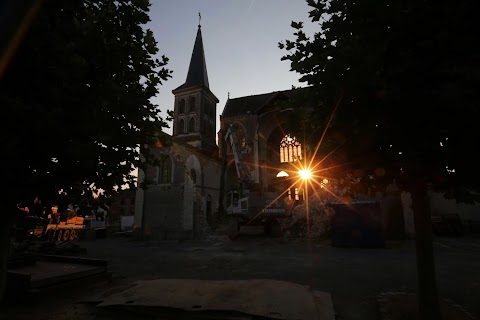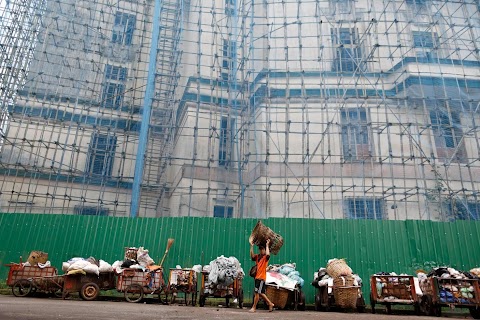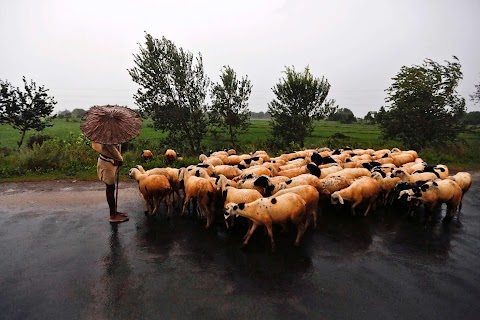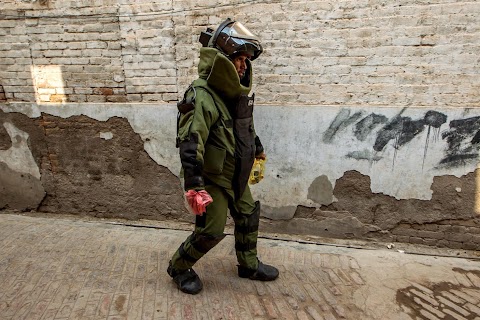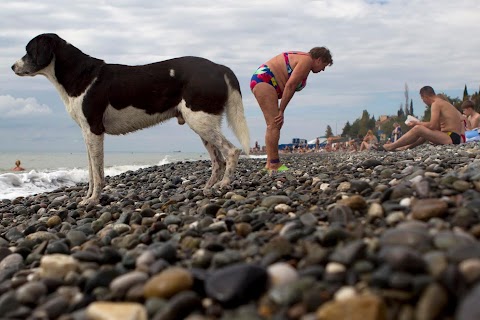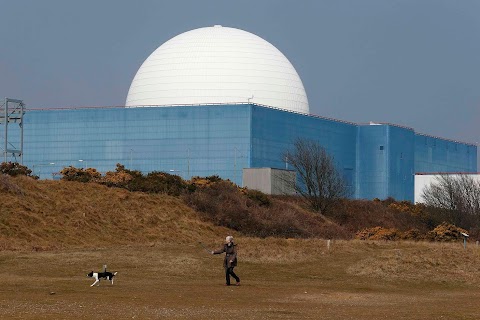
Nuclear Britain
 Suzanne Plunkett
Suzanne Plunkett
This image of a woman walking her dog would look like a normal countryside scene, were it not for the huge nuclear power station looming up in the background.
This is Sizewell B, the only nuclear plant in Britain not set to close by the end of 2023. But the potential for a new generation of nuclear reactors is growing; Britain has just opened the door to major Chinese investment in the country’s future nuclear facilities.

Britain’s nuclear plants are scattered around the country, from the shingle beaches and salty marshland that surround Dungeness power station in southern England, to the Hunterston plant, pictured here rising above the misty landscape by the Scottish coast.
These power plants currently produce just under a fifth of the country’s electricity. As they start to go out of service, Britain needs foreign investment to pay the huge upfront costs involved in renewing them.
The country has now cleared the way for some of that money to come from China, after Chancellor George Osborne signed an agreement opening the door to Chinese investors taking majority stakes in future nuclear plants.
The government has also said it is "extremely close" to a deal with French energy company EDF related to building Britain's first new nuclear power station since 1995, a project which is likely to involve China General Nuclear Power Group.

All of Britain’s current nuclear power stations are in relatively remote locations near the coast, but this does not mean that the landscape around them is deserted.
Dungeness power station, for example, is within a nature reserve, and attracts day visitors, fishermen and birdwatchers like these two enthusiasts, Malcolm McVail and Barry Woolhouse.
Slideshow

A dry stone wall surrounds a field outside Torness nuclear power station in Dunbar, by the eastern Scottish coast.

A pair of abandoned shoes lie on a stoney beach outside Sizewell nuclear power station in eastern England.

Dutch ornithologist Hans van Brandwijk uses binoculars to look for migrating seabirds by the Dungeness nuclear plant.

Wind turbines stand on the hills behind Hunterston power station in West Kilbride, Scotland.

A miniature steam train drives past Dungeness.

A house stands in front of the Dungeness nuclear facility.

Lacey curtains hang in the windows of holiday caravans near Heysham nuclear power station in the northwest of England.

Seaweed covers rocks in Morecambe Bay outside the Heysham plant.

Hinkley Point nuclear power station is seen behind rocks on a beach in Bridgwater, in the southwest of England.

Workers lean on a set of railings in front of the stark architecture of Wylfa nuclear power station in northern Wales.

Eglwys Llanbadrig Church stands near the Wylfa power plant.

Sheep graze on a hill across the bay from Wylfa.

Horses walk through the muddy ground at Hartlepool nuclear power plant, just outside Seaton Carew, northeast England.

A man boards a bus near the Hartlepool plant.

Car lights stream past a home near Dungeness nuclear power station.
"Overshadowing everything is the nuclear power station, filling the icy sea air with its powerful electric hum."
It sounds like the road trip from hell: a journey around all Britain’s functioning nuclear power stations.
After all, when the UK has so much to offer the traveller – from the bright lights of London to the ancient ruins of Stonehenge – why would anyone go out of their way to visit the far-flung places where the country has stowed its grim industrial reactor halls?
Memories of the Fukushima and Chernobyl meltdowns don’t help. For all its green credentials, nuclear energy seems forever tainted by the consequences of its few disasters. Thoughts of abandoned cities, stark yellow and black hazard symbols and the sickening effects of leaking radiation are never far away.
With all this at the back of my mind, and an itinerary that featured bleakly-named destinations like Hinkley Point B, Heysham 2 and Sizewell B, I wasn’t exactly expecting an uplifting experience.
I was wrong.
My first stop was Dungeness, a sparse, low landscape of scattered pebbles and salty marshland that bulges out of the coastline of England’s otherwise leafy southeastern county of Kent. Here the sky is vast, dwarfing the wooden houses and tumbledown fishing shacks that litter the landscape.
Overshadowing everything is the nuclear power station, filling the icy sea air with its powerful electric hum.
By rights, this place should be deserted, but it isn’t. The power station is set inside a nature reserve. There’s a pub, a miniature functioning steam train and no fewer than two lighthouses. The area was packed with day-trippers, fishermen, birdwatchers, railway enthusiasts and even some fashionistas, scouting locations for a magazine photo shoot.
I talked to anglers who told fishy tales of giant sea beasts that get pulled into the reactor’s cooling systems. I met a windswept Dutch ornithologist whose lifelong obsession with a single breed of bird, the Pomarine Skua has taught him that Dungeness is the closest to land the bird comes on its migration route.
This was a situation I would find repeated, in various ways, at the other stops on my route. Because of their thirst for cooling seawater, all of the UK’s nuclear power stations are sited on the coast. Perhaps because of safety concerns, these are all in remote – and consequently beautiful – locations, where their presence seems to enhance a sense of the surreal.
And so, as I continued my nuclear tour, I was later to find myself in a Somerset village where Samuel Taylor Coleridge once penned drug-infused poetry, among ancient graves outside a church founded by St. Patrick, in the garden of the late filmmaker Derek Jarman, and in the Scottish birthplace of John Muir, a hero in my home country, the United States, for his work to preserve wildlife and establish national parks.
I encountered golfers, anglers, ornithologists, joggers, dog walkers, hikers and proud homeowners hanging up their laundry – all seemingly oblivious to the immense nuclear reactions taking place in the nearby turbine halls or the web of power lines and pylons sprawling over their heads.
There was also a Welsh railway station named Llanfairpwllgwyngyllgogerychwyrndrobwllllantysiliogogogoch, Don’t try to pronounce it. It’s probably easier to split the atom.
As it became clear that photographing Britain’s nuclear facilities was as much about the poetry of the landscape as the prose of the power station architecture, I began to adopt a system to help get the most out of my visits.
I tracked the movements of the sun, and made use of the pinpoint cartography of Britain’s Ordnance Survey maps, as well as tide tables. So armed, I would know the exact direction and time of sunrise and sunset, when the sea would retreat to allow me to shoot inland, and which roads would give me high vantage points.
Although several of the reactors sit in public nature parks, I still found myself getting stopped by armed police deployed to guard what are considered key sites of national security. With my large lenses raising suspicions, I had background checks performed on me at four of the eight nuclear power stations I visited.
I imagine I avoided being stopped at all of them because early on I had provided the police with my credentials and, much to their amusement, a detailed list of my itinerary which one officer said he would phone ahead to my next destination. He was clearly having a quiet day as he recommended restaurants and scenic routes I should try along the way.
For those working in and around Britain’s nuclear power industry, these are interesting times. Although the UK currently sources around 20 percent of its electricity from nuclear, all but one of its stations are scheduled to close by 2023.
But a new generation of nuclear reactors may be on the horizon. The government has said it is very close to striking a deal with the French firm EDF about building Britain’s first new nuclear plant in almost two decades. What’s more, the UK has just cleared the way for major Chinese investment in new nuclear facilities, bringing it closer to finding the huge amounts of money necessary to build future plants.
For all my delight at discovering the natural beauty surrounding the reactors, the reality of what goes on inside was brought home when I gained access to Hinkley Point B, a power facility on the coastline of western Somerset, operated by the French company EDF.
Here I was able to take photographs inside the charge hall where a floor shield known as the pile cap covers one of two reactors that produce, on a good day, enough electricity to power 1.5 million households.
I was given a boiler suit, eye, ear, head and foot protection, and accompanied by two employees from EDF who took me on a tour of the turbine and charge halls. It was here that I experienced the highlight of my unusual road trip.
Because even though I saw some of Britain’s most stunning scenery, met interesting people and got to stand on top of one of two reactors whose atomic hearts are capable of powering around 6 percent of the UK’s homes, nothing beat the automated voice that concluded a full body scan at the end of my visit, with the words: “You are not contaminated.”
